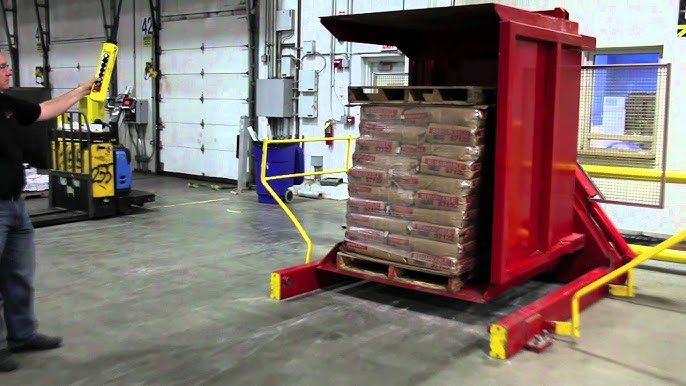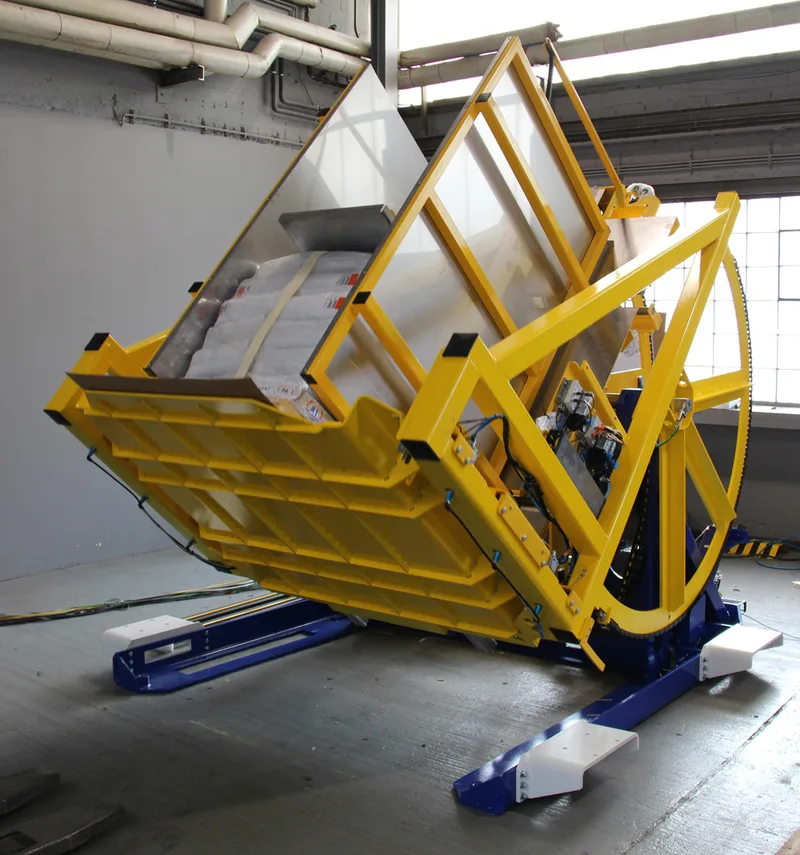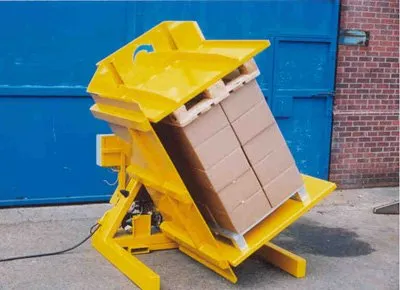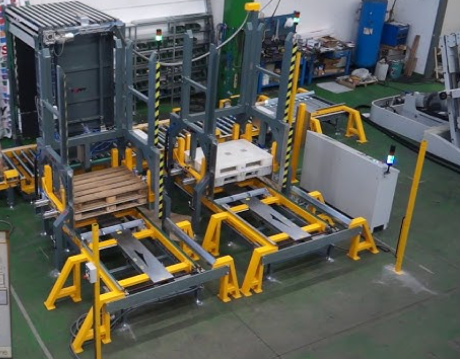Cutting Downtime in Mexico: How Pallet Changing Machines Help
Are you running a steel mill in Mexico? Then you understand the pressure. Every minute of downtime costs you money. Your production schedule is tight, and market demands are always changing. You have aging equipment, rising energy costs, and strict environmental regulations to worry about. The constant fight to keep your lines running efficiently feels like a battle you can't afford to lose. What if I told you a simple piece of equipment, often overlooked, could be a key part of the solution? A solution that tackles downtime, reduces costs, and improves safety all at once.
A pallet changing machine, or pallet inverter, helps cut downtime in demanding environments like a Mexican steel mill by automating the process of transferring goods from one pallet to another. This eliminates slow, dangerous, and error-prone manual handling. By doing this, it speeds up logistics, reduces product damage, and frees up workers for more valuable tasks. This directly increases operational efficiency and equipment uptime.

I've been in the packaging machine industry for a long time. I started on the factory floor and eventually built my own company, SHJLPACK. I’ve seen firsthand how small changes can have a huge impact. I remember visiting a steel plant facing the exact same challenges you are. They saw pallet changing as a minor issue. But by looking closer, we discovered it was a major bottleneck affecting their entire operation. In this article, I want to share what I've learned. We will explore how these machines work and how they can become a strategic asset for your steel mill in Mexico. Let's dig in.
What is a Pallet Changing Machine and How Does It Work in a Steel Mill?
You see a bottleneck in your shipping department. Workers are manually restacking heavy steel coils or wire spools from your internal, heavy-duty pallets to shipping pallets. It’s slow, it’s physically demanding, and occasionally, a product gets damaged. You worry about worker safety and the inefficiencies that ripple back into your production line. You need a better way, a machine that can handle these heavy loads quickly and safely.
A pallet changing machine is a piece of equipment designed to safely and efficiently transfer a full load of products from one pallet to another. In a steel mill, it handles heavy and often unstable loads like stacked steel coils, wire spools, or finished metal parts. The most common type is a pallet inverter, which clamps the entire load (including the original pallet), rotates it 180 degrees, and allows the old pallet to be removed from the top. Then, the new pallet is placed on top, and the load is rotated back.

Dive Deeper: The Mechanics and Applications in Steel Manufacturing
To truly understand the value, you need to look at the different types of pallet changers and how they specifically apply to the unique challenges of a steel mill. The choice of machine depends entirely on your product, your workflow, and your space.
Types of Pallet Changers
There are two main categories of machines you should consider:
-
Pallet Inverters: This is the workhorse for many industries, including steel. As I mentioned, it works by clamping and rotating the load.
- How it works: A hydraulic or electric system clamps the load from both sides. The entire unit then rotates 180 degrees. The pallet that was on the bottom is now on top and can be easily removed. The new pallet is put in its place, and the load is rotated back to its original position.
- Best for: Robust, stable products that can handle rotation. This is perfect for stacked steel sheets, blocks, or tightly wound coils that won't shift during inversion.
-
Pallet Pushers/Exchangers: These machines work without tipping or inverting the load.
- How it works: A side wall supports the product while a pusher plate gently slides the entire load from the old pallet onto a new pallet waiting right next to it.
- Best for: Unstable or fragile loads that cannot be tilted or inverted. Think of loosely stacked boxes of finished parts or sensitive components.
Here is a simple breakdown for a steel mill environment:
| Feature | Pallet Inverter | Pallet Pusher/Exchanger |
|---|---|---|
| Mechanism | Clamps and rotates 180° | Pushes load from one pallet to another |
| Ideal Load | Stable, heavy products (steel coils, sheets) | Unstable or sensitive products (boxed parts) |
| Speed | Very fast cycle time (often under 60 seconds) | Slightly slower cycle time |
| Footprint | Typically requires more vertical space | Can be more compact, often integrated into conveyors |
| Key Advantage | Robust, simple mechanism, great for heavy loads | Gentle handling, keeps load upright |
In my experience, for most heavy-duty applications in a Mexican steel mill, the pallet inverter is the go-to choice. It's incredibly reliable and can be built to handle extreme weights. We once designed a custom inverter for a client that needed to handle 3-ton loads of steel wire. The key was ensuring the clamping pressure was perfectly calibrated to hold the load securely without damaging the product. This is where partnering with an experienced manufacturer is crucial.
How Can Pallet Changers Directly Address the Challenge of Aging Equipment?
Your production lines have been running for over 15 years. You know the equipment is getting old. Breakdowns are becoming more frequent, and finding spare parts is a headache. This unscheduled downtime kills your productivity and makes it impossible to meet your goal of 95% uptime. You can't afford a full line replacement, so you're looking for smart, targeted upgrades that can make the biggest impact on stability and reduce the strain on your older machinery.
Pallet changers directly address the challenge of aging equipment by isolating and automating a historically manual and failure-prone process. Instead of having a breakdown in the middle of a complex production line, you move the pallet-handling task to a dedicated, modern, and reliable machine. This reduces the operational strain on your older conveyor systems and lifts. It creates a stable, predictable buffer at the end of your line, preventing logistical bottlenecks from causing a complete production shutdown.

Dive Deeper: Decoupling Processes for Higher Uptime
The concept here is "decoupling." In manufacturing, this means creating independence between two sequential processes so that a failure in one does not immediately stop the other. When you rely on manual pallet handling or an old, integrated palletizing system at the end of your line, everything is tightly coupled. If a forklift is unavailable, a worker is on break, or the old palletizer jams, your entire production line can grind to a halt.
A standalone pallet changer decouples your main production from your final packaging and shipping logistics. Your production line can continue to output finished goods onto internal pallets, which are then queued for the pallet changer. The pallet changer works independently to transfer these goods to shipping pallets. This creates a buffer. Even if there's a delay in shipping, your main line can keep running for a period of time.
Let's look at the failure points in both scenarios.
Failure Points: Manual vs. Automated Pallet Changing
| Manual Pallet Handling (Tightly Coupled) | Automated Pallet Changing (Decoupled) |
|---|---|
| Worker Availability: Requires 1-2 workers. Subject to breaks, shift changes, or reassignment. | Machine Availability: Runs 24/7 with minimal supervision. |
| Equipment Dependency: Relies on available forklifts, which may be needed elsewhere. | Self-Contained: The machine is a dedicated, single-purpose unit. |
| Process Speed: Slow and variable. Depends on worker speed and fatigue. | Process Speed: Fast and consistent. Cycle times are predictable. |
| Risk of Failure: High risk of product damage from drops. High risk of worker injury. | Risk of Failure: Very low risk of product damage. Significantly improved safety. |
| Downtime Impact: A delay here can immediately stop the upstream production line. | Downtime Impact: Creates a buffer. Production can continue while the pallet changer catches up. |
I worked with a steel tube manufacturer in Monterrey. Their main forming and cutting line was a workhorse, but the end-of-line packaging was a mess. They used a 20-year-old strapping machine and manual palletizing. When the old strapper failed, the whole line stopped. We introduced a modern wrapping machine and a pallet inverter. The production line now feeds finished tube bundles to a staging area. The pallet inverter then takes these bundles and transfers them to heat-treated pallets for export. The two processes are decoupled. Their line uptime increased by 12% in the first six months, not because the main line was faster, but because it never had to stop for a packaging problem again. This is a powerful strategy when dealing with aging assets.
Can Pallet Changers Contribute to Cost Reduction and Profitability Goals?
As a CEO, you have a clear target: reduce overall operating costs by 8% or more without sacrificing quality. You're analyzing every expense, from the massive energy bills to labor costs. You need investments that deliver a clear and measurable Return on Investment (ROI). You might see a pallet changer as just another piece of equipment to buy and maintain, but how does it actually help you lower costs and hit that critical profitability target?
Yes, pallet changers directly contribute to cost reduction and improved profitability in several ways. They reduce direct labor costs by automating a manual task. They minimize expensive product damage that occurs during manual handling. They speed up the entire logistics chain, allowing you to ship more products faster with the same resources. Finally, they improve worker safety, which reduces the significant direct and indirect costs associated with workplace injuries.

Dive Deeper: The ROI of Automated Pallet Handling
To convince a practical business leader like yourself, we need to look at the numbers. The ROI for a pallet changer is not abstract; it's based on tangible savings. Let's break down the key areas where you will see financial benefits. I encourage you to plug in your own numbers to see the potential impact on your steel mill.
1. Labor Cost Savings
This is the most straightforward calculation.
- Manual Method: How many employees are dedicated to manually re-stacking pallets per shift? Let's say it's two workers.
- Automated Method: A pallet changer requires only one operator, and often that person can manage the machine while performing other duties. This can effectively re-assign 1.5 workers per shift.
- Calculation: (Number of Workers Re-assigned) x (Annual Salary + Benefits) x (Number of Shifts) = Annual Labor Savings.
- For a three-shift operation, this could easily exceed $50,000 USD annually, depending on local wages in Mexico.
2. Reduction in Product Damage
In a steel mill, products are heavy. A dropped coil or a damaged bundle of finished parts is not just a write-off; it's a significant loss.
- Damage Rate: What is your current rate of product damage from manual handling? Even a conservative 0.5% of products handled can add up.
- Automated Handling: A pallet inverter handles the load securely. The risk of dropping or damaging the product is virtually eliminated.
- Calculation: (Total Value of Products Handled Annually) x (Manual Damage Rate %) = Annual Savings from Damage Reduction.
- For a facility moving millions of dollars of product, saving even 0.5% is a huge number.
3. Increased Throughput and Efficiency
- Manual Cycle Time: How long does it take for two workers to manually transfer a full pallet? 10-15 minutes is common for heavy loads.
- Automated Cycle Time: A pallet inverter can complete a cycle in 60-90 seconds.
- Impact: This massive speed increase eliminates a major bottleneck. It means trucks are loaded faster, and you can process more shipments per day without adding staff. This "opportunity cost" is harder to quantify but directly impacts revenue.
Here's a sample ROI analysis:
| Cost / Savings Area | Calculation Example (Annual) | Estimated Value (USD) |
|---|---|---|
| Investment (One-Time) | Pallet Changer Cost + Installation | -$75,000 |
| Labor Savings | 1.5 workers x $20,000/yr x 3 shifts | +$90,000 |
| Damage Reduction | 0.5% of $10M in product value | +$50,000 |
| Maintenance | Annual service and parts | -$5,000 |
| Net First-Year Gain | Total Savings - Total Costs | +$60,000 |
| Payback Period | Investment / Net Annual Gain | ~1.25 Years |
This is a simplified model, but it illustrates the point. The investment pays for itself very quickly. From my own journey, I learned that the best investments were not always the biggest ones. They were the ones that solved a critical, recurring problem. Manual pallet handling is one of those problems. Solving it pays dividends every single day.
Why Should a Mexican Steel Mill CEO Consider a Pallet Changer a Strategic Investment?
You're a CEO, not just a plant manager. You think long-term. You're looking for strategic partners, not just equipment suppliers. You need solutions that not only solve today's problems but also align with your future goals for digitalization and sustainability. So, you might ask, "Is a pallet changer just a piece of metal, or is it a strategic tool that fits into my bigger picture for the company?"
A Mexican steel mill CEO should consider a pallet changer a strategic investment because it is a foundational step towards automation and data-driven manufacturing. It is not just a machine; it is an enabling technology. It enhances worker safety, a key component of corporate social responsibility. It generates process data that can be fed into your MES or ERP systems for better tracking. And it demonstrates a commitment to modernization and efficiency that strengthens your competitive position in a volatile market.

Dive Deeper: Beyond the Machine - A Building Block for the Future
Thinking strategically means seeing the second- and third-order effects of an investment. A pallet changer does more than just swap pallets. It acts as a catalyst for broader improvements across your operation, aligning perfectly with your goals for digital transformation and operational excellence.
1. A Gateway to Digitalization (Your Goal: Deploy MES, IoT)
Modern pallet changers are not isolated islands. They are smart machines.
- Data Generation: They can be equipped with sensors to track key data points: cycle times, load weights (with integrated scales), number of pallets changed per shift, and operational hours.
- System Integration: This data is not just for a local display. It can be exported. Through simple industrial protocols (like OPC-UA or Modbus TCP/IP), the pallet changer can communicate directly with your Manufacturing Execution System (MES).
- What this means for you: You get real-time visibility into your end-of-line logistics. Your MES knows exactly when a pallet of finished goods is ready for shipment. This improves inventory accuracy and allows your smart scheduling platform to make better decisions. It’s a tangible step towards the comprehensive production visualization you want to achieve.
2. Enhancing Environmental and Corporate Governance (ESG)
- Worker Safety: As I’ve said, automating this process dramatically reduces the risk of musculoskeletal injuries. This is a huge win for your employees and your company's safety record. In today's world, a strong safety culture is a key part of good corporate governance and can be a competitive advantage when attracting talent.
- Pallet Reuse and Recycling: Pallet changers make it easy to separate internal, high-quality pallets from lower-cost, one-way shipping pallets. This allows you to extend the life of your expensive internal pallets and ensures you are sending out compliant (e.g., heat-treated ISPM 15) pallets for export, avoiding costly delays at the border. This supports a more sustainable and cost-effective pallet management strategy.
3. A Foundation for Further Automation
I've seen it many times. The pallet changer is often the first, easiest step in automating a warehouse or shipping area. Once it's in place and proving its value, the next logical steps become clear.
- Phase 1: Install the standalone pallet changer.
- Phase 2: Add automated conveyors to feed pallets into the machine.
- Phase 3: Integrate Automated Guided Vehicles (AGVs) to transport pallets from the production line to the changer, and then to the shipping bay.
By starting with a pallet changer, you are not just solving one problem. You are laying a critical piece of infrastructure for a fully automated, efficient, and data-rich logistics process. For a forward-thinking CEO like you, it’s a low-risk, high-reward investment that pays immediate dividends while paving the way for your long-term strategic vision.
My Take: It's About More Than Just Changing Pallets
I want to end with a personal thought. Through my years building SHJLPACK, I’ve realized that my job isn’t just about selling machines. My mission is to share the knowledge I’ve gained to help people solve problems. I achieved my own success in this industry, and now I want to help others do the same.
When I talk to a steel mill owner like Javier, I don't just see a potential customer. I see a fellow engineer and entrepreneur facing immense pressure. I see the weight of responsibility for hundreds of employees and the challenge of navigating a tough global market.
The reason I'm so passionate about equipment like pallet changers is because I've seen the ripple effect they have. I remember one client in particular. He was skeptical. He saw it as a "nice-to-have," not a necessity. His biggest concern was an aging workforce and recurring back injuries in his shipping department. We installed a pallet inverter, and six months later, he called me.
He didn't start by talking about the ROI or the cycle time. He started by telling me that his lead shipping foreman, a man who had been with the company for 30 years, pulled him aside and said, "Thank you. For the first time in years, I don't have back pain at the end of my shift."
That's the real impact. Yes, the machine will reduce your costs. It will increase your uptime. It will help you hit your 8% cost reduction target. But it will also do more. It will make your workplace safer. It will improve the morale of your team. It will show your employees that you are investing in them, not just in production numbers. It sends a powerful message that you are building a modern, sustainable, and human-centric operation.
That, to me, is the true meaning of a strategic investment. It’s a solution that improves both the balance sheet and the lives of the people who make your company run.
Conclusion
Ultimately, pallet changing machines are a powerful tool. They cut downtime, reduce costs, and improve safety, making them a smart, strategic investment for any modern steel mill in Mexico.


